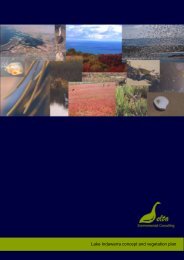Mangrove Cove
Environmental Management Plan for Mangrove Cove - Delta ...
Environmental Management Plan for Mangrove Cove - Delta ...
- No tags were found...
Create successful ePaper yourself
Turn your PDF publications into a flip-book with our unique Google optimized e-Paper software.
Delta<br />
<strong>Mangrove</strong> <strong>Cove</strong> Management Plan<br />
7.9 Monitoring success of widgeon grass & seagrass planting<br />
Annually lay out a marked string line across the area planted with seagrasses. Make sure the<br />
line extends beyond the planted area at both ends. Use a fixed point to run the line from (eg a<br />
post on the Trafalgar). Photograph the extent of the planted area, if it is small enough. If the<br />
area is large, photograph several evenly spaced points along the line. Be sure to include the<br />
tape in the photographs. The spread of the plants can be estimated from this measure, as well<br />
as the density (coverage) of the plants.<br />
7.10 Monitoring mangrove expansion<br />
<strong>Mangrove</strong> expansion is an expected occurrence in the reserve however expansion that results<br />
in a monoculture, or that completely hides the Ships Graveyard, is not desirable. Should<br />
annual salting of the wrecks and saltmarshes be undertaken, then several photo points should<br />
be set up at the <strong>Cove</strong> to monitor the effectiveness of this program.<br />
Photo points should be placed perpendicular to embankments, looking across the leading edge<br />
of the mangroves. There should be two locations where no salting will be occurring<br />
(mangrove/mudflat or mangrove/saltmarsh interfaces), and two locations where salting will be<br />
occurring (mangrove/saltmarsh interface). Suggested locations for the photo points are shown<br />
in Figure 11 – Monitoring locations. Each view should include a fixed object (eg parts of a<br />
wreck or a stake) that is a known size. This will provide a scale in the photographs. A short<br />
stake or other fixed point should be driven into the ground where the camera will be placed<br />
for each photograph. In this way each year’s photograph will be able to be overlaid on the<br />
previous year to detect change.<br />
Heights and breadths of the mangrove fringe may be calculated from these photographs. A<br />
new photo point may be established as the mangrove zone expands.<br />
7.11 Monitoring saltmarsh plantings<br />
Should an area for saltmarsh retreat be constructed and planted, a record shall be kept, by the<br />
developer, of the original plantings and their placements (a planting plan). A fixed photo<br />
point shall be established on the filled area of the site with a view that encompasses the<br />
saltmarsh retreat site as shown in Figure 11 – Monitoring locations. A photograph shall be<br />
taken on completion of planting and at least annually after that.<br />
To determine specific species’ success, a line transect, as detailed in the Waterwatch SA<br />
Estuarine Monitoring Guidelines (Coleman and Cook, 2003) may be undertaken, if desired. A<br />
suggested location for a transect in the saltmarsh retreat zone is shown in Figure 11 –<br />
Monitoring locations. Record the details on the vegetation transect monitoring sheet provided.<br />
7.12 Using aerial photographs to map habitat change<br />
Aerial photography is the easiest method of identifying the extent of gross habitat change. A<br />
simple classification of georectified aerial photography into three classifications (mangrove,<br />
saltmarsh and mud flat) will suffice. If aerial photography is purchased from Mapland every<br />
LMC-MCR-001-PC/RE Page 47



